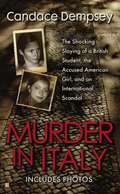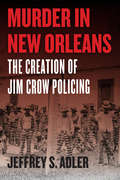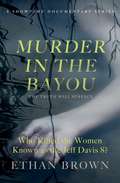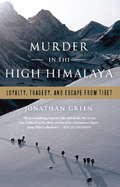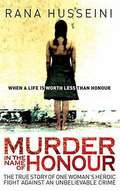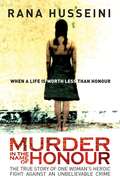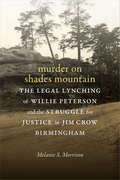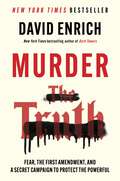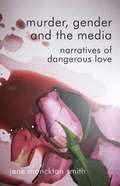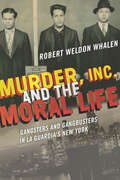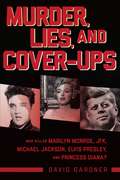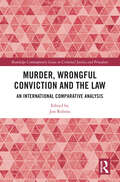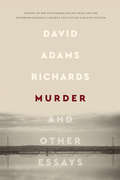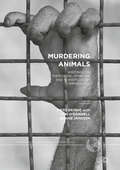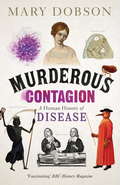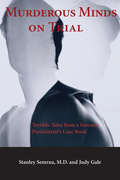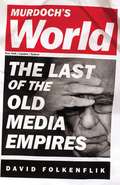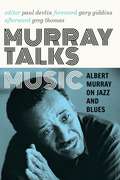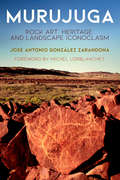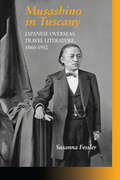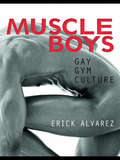- Table View
- List View
Murder in Italy
by Candace DempseyThe true story behind the notorious international murder--updated to cover Amanda Knox's acquittal. In Perugia, Italy, on November 2, 2007, police discovered the body of a British college student stabbed to death in her bedroom. The prosecutor alleged that the brutal murder had occurred during a drug-fueled sex game gone wrong. Her housemate, American honor student Amanda Knox, quickly became the prime suspect and soon found herself the star of a sensational international story, both vilified and eroticized by the tabloids and the Internet. Award-winning journalist Candace Dempsey gives readers a front-row seat at the trial and reveals the real story behind the media frenzy. "Beautifully researched, well-written, and clearly organized. Dempsey was the first journalist in the United States to raise questions about the Amanda Knox case, and the first to look deeply into the facts and begin to uncover the shocking truth. If you want to know the real story . you must read this book, reprinted after Knox's acquittal with a new ending."-Douglas Preston, New York Times bestselling author (with Mario Spezi) of The Monster of Florence
Murder in Italy
by Candace DempseyThe true story behind the notorious international murder--updated to cover Amanda Knox's acquittal.In Perugia, Italy, on November 2, 2007, police discovered the body of a British college student stabbed to death in her bedroom. The prosecutor alleged that the brutal murder had occurred during a drug-fueled sex game gone wrong. Her housemate, American honor student Amanda Knox, quickly became the prime suspect and soon found herself the star of a sensational international story, both vilified and eroticized by the tabloids and the Internet.Award-winning journalist Candace Dempsey gives readers a front-row seat at the trial and reveals the real story behind the media frenzy. "Beautifully researched, well-written, and clearly organized. Dempsey was the first journalist in the United States to raise questions about the Amanda Knox case, and the first to look deeply into the facts and begin to uncover the shocking truth. If you want to know the real story . you must read this book, reprinted after Knox's acquittal with a new ending."-Douglas Preston, New York Times bestselling author (with Mario Spezi) of The Monster of Florence
Murder in New Orleans: The Creation of Jim Crow Policing (Historical Studies of Urban America)
by Jeffrey S. AlderNew Orleans in the 1920s and 1930s was a deadly place. In 1925, the city’s homicide rate was six times that of New York City and twelve times that of Boston. Jeffrey S. Adler has explored every homicide recorded in New Orleans between 1925 and 1940—over two thousand in all—scouring police and autopsy reports, old interviews, and crumbling newspapers. More than simply quantifying these cases, Adler places them in larger contexts—legal, political, cultural, and demographic—and emerges with a tale of racism, urban violence, and vicious policing that has startling relevance for today.Murder in New Orleans shows that whites were convicted of homicide at far higher rates than blacks leading up to the mid-1920s. But by the end of the following decade, this pattern had reversed completely, despite an overall drop in municipal crime rates. The injustice of this sharp rise in arrests was compounded by increasingly brutal treatment of black subjects by the New Orleans police department. Adler explores other counterintuitive trends in violence, particularly how murder soared during the flush times of the Roaring Twenties, how it plummeted during the Great Depression, and how the vicious response to African American crime occurred even as such violence plunged in frequency—revealing that the city’s cycle of racial policing and punishment was connected less to actual patterns of wrongdoing than to the national enshrinement of Jim Crow. Rather than some hyperviolent outlier, this Louisiana city was a harbinger of the endemic racism at the center of today’s criminal justice state. Murder in New Orleans lays bare how decades-old crimes, and the racially motivated cruelty of the official response, have baleful resonance in the age of Black Lives Matter.
Murder in the Bayou: Who Killed the Women Known as the Jeff Davis 8?
by Ethan BrownAn explosive, true-life southern gothic story, Murder in the Bayou chronicles the twists and turns of a high-stakes investigation into the murders of eight women in a troubled Louisiana parish.Between 2005 and 2009, the bodies of eight women were discovered around the murky canals and crawfish ponds of Jennings, Louisiana, a bayou town of 10,000 in the heart of the Jefferson Davis parish. Local law enforcement officials were quick to pursue a serial killer theory, opening a floodgate of media coverage--from CNN to The New York Times. Collectively the victims became known as the "Jeff Davis 8," and their lives, their deaths, and the ongoing investigation reveals a small southern community's most closely guarded secrets. As Ethan Brown suggests, these homicides were not the work of a single serial killer, but the violent fallout of Jennings' brutal sex and drug trade, a backwoods underworld hidden in plain sight. Mixing muckraking research and immersive journalism over the course of a five-year investigation, Ethan Brown reviewed thousands of pages of previously unseen homicide files to determine what happened during each victim's final hours. Epic in scope and intensely suspenseful, Murder in the Bayou is the story of an American town buckling under the dark forces of poverty, race, and class division--and a lightning rod for justice for the daughters it lost.
Murder in the High Himalaya: Loyalty, Tragedy, and Escape from Tibet
by Jonathan GreenOn September 30, 2006 gunfire echoed through the thin air near Advance Base Camp on Cho Oyu Mountain. Frequented by thousands of climbers each year, Cho Oyu lies nineteen miles east of Mt. Everest on the border between Tibet and Nepal. To the elite mountaineering community, it offers a straightforward summit-a warm-up climb to her formidable sister. To Tibetans, Cho Oyu promises a gateway to freedom through a secret glacial path: the Nangpa La. Murder in the High Himalaya is the unforgettable account of the brutal killing of Kelsang Namtso-a seventeen-year-old Tibetan nun fleeing to India-by Chinese border guards. Witnessed by dozens of Western climbers, Kelsang’s death sparked an international debate over China’s savage oppression of Tibet. Adventure reporter Jonathan Green has gained rare entrance into this shadow-land at the rooftop of the world. In his affecting portrait of modern Tibet, Green raises enduring questions about morality and the lengths we go to achieve freedom.
Murder in the Name of Honor: The True Story of One Woman's Heroic Fight Against an Unbelievable Crime
by Rana HusseiniMurder in the Name of Honor is Rana Husseini's hard-hitting and controversial examination of honor crimes. Common in many traditional societies around the world, as well as in migrant communities in Europe and the USA, they involve a 'punishment'-often death or disfigurement-carried out by a relative to restore the family's honor. Breaking through the conspiracy of silence surrounding this crime, one writer above all others has been instrumental in bringing it to the world's attention: Rana Husseini. Journalist, feminist, and human rights defender, Jordanian Rana Husseini is one of the world's most influential investigative journalists, whose consistent reporting of honor crimes has put violence against women on the public agenda around the world. The recipient of numerous awards for bravery in journalism, she is a regular speaker at major international events, and has served as a consultant for several NGOs, including Equality Now and the United Nations Development Fund for Women. She has been interviewed on almost every major international broadcaster, from CNN to the BBC.
Murder in the Name of Honor: The True Story of a Woman's Heroic Fight Against an Unbelievable Crime
by Rana HusseiniA hard-hitting and controversial examination of honor crimes. Common in many traditional societies around the world, as well as in migrant communities in Europe and the USA, they involve a 'punishment'--often death or disfigurement--carried out by a relative to restore the family's honor. Breaking through the conspiracy of silence, one writer above all others has been instrumental in bringing it to the world's attention: Rana Husseini.
Murder on Shades Mountain: The Legal Lynching of Willie Peterson and the Struggle for Justice in Jim Crow Birmingham
by Melanie S. MorrisonOne August night in 1931, on a secluded mountain ridge overlooking Birmingham, Alabama, three young white women were brutally attacked. The sole survivor, Nell Williams, age eighteen, said a black man had held the women captive for four hours before shooting them and disappearing into the woods. That same night, a reign of terror was unleashed on Birmingham's black community: black businesses were set ablaze, posses of armed white men roamed the streets, and dozens of black men were arrested in the largest manhunt in Jefferson County history. Weeks later, Nell identified Willie Peterson as the attacker who killed her sister Augusta and their friend Jennie Wood. With the exception of being black, Peterson bore little resemblance to the description Nell gave the police. An all-white jury convicted Peterson of murder and sentenced him to death. In Murder on Shades Mountain Melanie S. Morrison tells the gripping and tragic story of the attack and its aftermath—events that shook Birmingham to its core. Having first heard the story from her father—who dated Nell's youngest sister when he was a teenager—Morrison scoured the historical archives and documented the black-led campaigns that sought to overturn Peterson's unjust conviction, spearheaded by the NAACP and the Communist Party. The travesty of justice suffered by Peterson reveals how the judicial system could function as a lynch mob in the Jim Crow South. Murder on Shades Mountain also sheds new light on the struggle for justice in Depression-era Birmingham. This riveting narrative is a testament to the courageous predecessors of present-day movements that demand an end to racial profiling, police brutality, and the criminalization of black men.
Murder the Truth: Fear, the First Amendment, and a Secret Campaign to Protect the Powerful
by David Enrich"Authoritarian governments abroad have long used legal threats and lawsuits against journalists to cover up their disinformation, corruption, and violence. Now, as master investigative journalist David Enrich reveals, those tactics have arrived in America.” — Ruth Ben-Ghiat, author of Strongmen. <p> David Enrich, the New York Times Business Investigations Editor and the #1 bestselling author of Dark Towers, produces his most consequential and far-reaching investigation yet: an in-depth exposé of the broad campaign—orchestrated by elite Americans—to silence dissent and protect the powerful. <p> It was a quiet way to announce a revolution: In an obscure 2019 case that the Supreme Court refused to even hear, Justice Clarence Thomas raised the prospect of overturning the legendary New York Times v. Sullivan decision. Though hardly a household name, Sullivan is one of the most consequential free speech decisions, ever. Fundamental to the creation of the modern media as we know it, it has enabled journalists and writers all over the country—from top national publications to revered local newspapers to independent bloggers—to pursue the truth aggressively and hold the wealthy, powerful, and corrupt to account. <p> Thomas’s words were a warning—the public awakening of an idea that had been fomenting on the conservative fringe for years. Now it is going mainstream. From the Florida statehouse to small town New Hampshire to Donald Trump's White House, this movement today consists of some of the world’s richest and most powerful people and companies, who believe they should be above scrutiny and want to silence or delegitimize voices that challenge their supremacy. Indeed, many of the same businessmen, politicians, lawyers, and activists are already weaponizing the legal system to intimidate and punish journalists and others who dare criticize them. <p> In this masterwork of investigative reporting, David Enrich, New York Times Business Investigations Editor, traces the roots and reach of this growing threat to our modern democracy. With Trump’s emboldened right-wing coalition committed to demonizing and punishing those who attempt to hold them accountable, Murder the Truth sounds the alarm about the looming war over facts, laying bare the stakes of losing our most sacrosanct rights. The result is a story about power in the age of Trump—the way it’s used by those who have it and the lengths to which they will go to avoid it being questioned. <b>New York Times Bestseller</b>
Murder, Gender and the Media
by Jane Monckton SmithThis volume is a shocking insight into the way the idea of romantic love can justify and excuse the killing of women by their spouses and partners, and lead to sympathy and reduced prison sentences for the killers. The author explores how stories of domestic homicide and love are told in the news, by the police, and in the courts, drawing from the reporting of 72 cases which happened in just one twelve month period. The findings make compelling reading and are important in understanding how we respond to domestic abuse and violence more generally, making clear the need to listen to victims more closely both before and after death. The book also includes a personal account of the aftermath of a double murder which was pivotal to the introduction of Domestic Homicide Reviews in the UK in April 2011.
Murder, Inc., and the Moral Life: Gangsters and Gangbusters in La Guardia's New York
by Robert Weldon WhalenIn 1940 and 1941 a group of ruthless gangsters from Brooklyn’s Brownsville neighborhood became the focus of media frenzy when they—dubbed “Murder Inc.,” by New York World-Telegram reporter Harry Feeney—were tried for murder. It is estimated that collectively they killed hundreds of people during a reign of terror that lasted from 1931 to 1940. As the trial played out to a packed courtroom, shocked spectators gasped at the outrageous revelations made by gang leader Abe “Kid Twist” Reles and his pack of criminal accomplices.News of the trial proliferated throughout the country; at times it received more newspaper coverage than the unabated war being waged overseas. The heinous crimes attributed to Murder, Inc., included not only murder and torture but also auto theft, burglary, assaults, robberies, fencing stolen goods, distribution of illegal drugs,and just about any “illegal activity from which a revenue could be derived.” When the trial finally came to a stunning unresolved conclusion in November 1941, newspapers generated record headlines.Once the trial was over, tales of the Murder, Inc., gang became legendary, spawning countless books and memoirs and providing inspiration for the Hollywood gangster-movie genre. These men were fearsome brutes with an astonishing ability to wield power. People were fascinated by the “gangster” figure, which had become a symbol for moral evil and contempt and whose popularity showed no signs of abating. As both a study in criminal behavior and a cultural fascination that continues to permeate modern society, the reverberations of “Murder, Inc.” are profound, including references in contemporary mass media.The Murder, Inc., story is as much a tale of morality as it is a gangster history, and Murder, Inc., and the Moral Life by Robert Whalen meshes both topics clearly and meticulously, relating the gangster phenomenon to modern moral theory. Each chapter covers an aspect of the Murder, Inc., case and reflects on its ethical elements and consequences. Whalen delves into the background of the criminals involved, their motives, and the violent death that surrounded them; New York City’s immigrant gang culture and its role as “Gangster City”; fiery politicians Fiorello La Guardia and Thomas E. Dewey and the choices they made to clean up the city; andthe role of the gangster in popular culture and how it relates to “real life.” Whalen puts a fresh spin on the two topics, providing a vivid narrative with both historical and moral perspective.
Murder, Lies, and Cover-Ups: Who Killed Marilyn Monroe, JFK, Michael Jackson, Elvis Presley, and Princess Diana?
by David GardnerUncover the real truth behind mass media accounts of how they died, and learn the reason for their murders. These five deaths stopped the whole world in its tracks. We all famously recall where we were and what we were doing when JFK was assassinated, as well as the moments Elvis, Princess Diana, and Michael Jackson died. As for Marilyn Monroe, the candle flickered out long ago, but only now can the truth be told about how—and why—she died. After combing through thousands of recently declassified FBI files and interviewing key witnesses, crime analysts, and forensic experts during years of research, investigative writer David Gardner has unearthed new information that will transform the way we look at these iconic tragedies that have long fascinated and intrigued the general public. Murder, Lies, and Cover-Ups reveals that Elvis Presley died not as a self-obsessed caricature but as a genuine hero who may have signed his death warrant going undercover for the FBI; how Marilyn Monroe's secret affairs with JFK and his brother, Robert, left her in the crosshairs of a lethal conspiracy; why Princess Diana's death was no accident; who ordered President John F. Kennedy's assassination; and how on three occasions Michael Jackson “died” of painkiller drug overdoses in the months before his death. In the wake of new evidence and testimonies, Murder, Lies, and Cover-Ups provides many of the answers that have been elusive for so long, while explaining what it was about these enduring legends that made their legacies burn so bright.
Murder, Wrongful Conviction and the Law: An International Comparative Analysis (Routledge Contemporary Issues in Criminal Justice and Procedure)
by Jon RobinsThis collection brings together international experts to present a comparative analysis of wrongful conviction and criminal procedure. The volume takes an interdisciplinary approach with authors drawn from a broad range of backgrounds including law, psychology, forensics and journalism. All are experts in their field with direct experience of the investigation of wrongful conviction in their own countries. Focusing on the main areas of concern in their own jurisdiction, each author discusses common themes, including: the extent of the problem; the types of cases that feature in miscarriages of justice; the legal mechanism for the correction of a wrongful conviction; compensation for the wrongly convicted; public awareness and concern about the issue generally and in light of highprofile cases; and the extent to which wrongful conviction has driven criminal justice reform. The book will be essential reading for students, researchers and policy-makers interested in comparative law, criminology and psychology.
Murder: A Tale of Modern American Life
by Sara L. KnoxWhat exactly is it about murder that claims such a powerful hold on the American imagination? In this book, Sara L. Knox examines postwar America's preoccupation with this act of violence. Demonstrating how American culture both consumes and produces tales of murder, Knox examines numerous relevant narratives--news stories, psychiatric testimony, legal transcripts, fictional accounts, and examples from the thriving literary genre of true crime.In her approach to the telling of this cultural phenomenon, Knox draws on historical analysis and original research. She discusses such subjects as the continuing existence of capital punishment, the "sensational" American murderers Martha Beck and Ray Fernandez (aka the Honeymoon Killers), the connection between true crime books and romance narratives, and pulp murder novels of the 1930s and 1940s. Analyzing widespread interest in forensic psychiatry, sexuality, mortality, and the relation of gender to society's reactions to murder, Knox refers to the early work of David Brion Davis, Bill Ellis, and Joel Black. While demonstrating how society's focus has shifted from the act itself to the psychology of the murderer to the broader social forces at work, she discusses the writings of Willard Motley, William March, Curtis Bok, James Baldwin, and Kate Millett, among others.Full of anecdotes and insights, Murder is a lively meditation on American culture that includes not only close critical readings of individual texts but also everyday matters of murder's meaning. It will interest those involved with American studies, cultural studies, and true crime accounts.
Murder: And Other Essays
by David Adams RichardsA thrilling, revelatory collection from one of the most provocative and original literary voices in Canada today.David Adams Richards is one of Canada's greatest writers, his place in the pantheon ensured by seventeen novels of consistent power and vision. He is also the author of four marvelous non-fiction ruminations on religious faith, hockey, hunting and fishing and their roles in his and the nation's identities. His loyal readers may feel they know him well. But they also know that this is a writer who never fails to surprise. This new collection of essays--his first in a quarter-century--is rich with revelations and insights, deepening our appreciation for this major talent and offering a provoking thought on every page. Murder is one of David's great subjects. In his novels, in the Russian classics he loves and in his life, murder has been a shaping force. The title of this volume refers to a suite of essays on the subject: a hitchhiker with whom David strikes up an unnerving philosophical debate; the killers of the Miramichi and their victims; Caligula; the villains of Russian literature; and, forever in David's mind as he examines this grim topic, the self-deception involved in the allure of evil. But in this wide-ranging collection there is much to delight in too: married love; family; travel; the beauty of the natural world; even Wayne Gretzky is invited to the party. David's principled outlook and spirituality inform his thinking thoroughout. And he draws many of his favourite writers into the discussion--from Tolstoy to Dostoevsky, Mary Shelley to Alden Nowlan--revelling in their work, as we do in David's, as sources of ideas, inspiration and sheer literary pleasure. As a considerable bonus, the book also contains at its midpoint a literary debut: a slim but substantial collection of David's poetry.
Murdering Animals: Writings On Theriocide, Homicide And Nonspeciesist Criminology (Palgrave Studies In Green Criminology Ser.)
by Piers BeirneMurdering Animals confronts the speciesism underlying the disparate social censures of homicide and “theriocide” (the killing of animals by humans), and as such, is a plea to take animal rights seriously. Its substantive topics include the criminal prosecution and execution of justiciable animals in early modern Europe; images of hunters put on trial by their prey in the upside-down world of the Dutch Golden Age; the artist William Hogarth’s patriotic depictions of animals in 18th Century London; and the playwright J.M. Synge’s representation of parricide in fin de siècle Ireland. Combining insights from intellectual history, the history of the fine and performing arts, and what is known about today’s invisibilised sites of animal killing, Murdering Animals inevitably asks: should theriocide be considered murder? With its strong multi- and interdisciplinary approach, this work of collaboration will appeal to scholars of social and species justice in animal studies, criminology, sociology and law.
Murdering Masculinities: Fantasies of Gender and Violence in the American Crime Novel (Sexual Cultures #44)
by Gregory ForterThough American crime novels are often derided for containing misogynistic attitudes and limiting ideas of masculinity, Greg Forter maintains that they are instead psychologically complex and sophisticated works that demand closer attention. Eschewing the synthetic methodologies of earlier work on crime fiction, Murdering Masculinities argues that the crime novel does not provide a consolidated and stable notion of masculinity. Rather, it demands that male readers take responsibility for the desires they project on to these novels. Forter examines the narrative strategies of five novels--Hammett's The Glass Key, Cain's Serenade, Faulkner's Sanctuary, Thompson's Pop. 1280, and Himes's Blind Man with a Pistol--in conjunction with their treatment of bodily metaphors of smell, vision, and voice. In the process, Forter unearths a "generic unconscious" that reveals things Freud both discovered and sought to repress.
Murderous Contagion: A Human History Of Disease
by Mary DobsonDisease is the true serial killer of human history: the horrors of bubonic plague, cholera, syphilis, smallpox, tuberculosis and the like have claimed more lives and caused more misery than the depredations of warfare, famine and natural disasters combined. Murderous Contagion tells the compelling and at times unbearably moving story of the devastating impact of diseases on humankind - from the Black Death of the 14th century to the Spanish flu of 1918-19 and the AIDS epidemic of the modern era. In this book Mary Dobson also relates the endeavours of physicians and scientists to understand and identify the causes of diseases and find ways of preventing them.This is a timely and revelatory work of popular history by a writer whose knowledge of, and enthusiasm for, her subject shines through her every word.
Murderous Contagion: A Human History of Disease
by Mary DobsonDisease is the true serial killer of human history: the horrors of bubonic plague, cholera, syphilis, smallpox, tuberculosis and the like have claimed more lives and caused more misery than the depredations of warfare, famine and natural disasters combined. Murderous Contagion tells the compelling and at times unbearably moving story of the devastating impact of diseases on humankind - from the Black Death of the 14th century to the Spanish flu of 1918-19 and the AIDS epidemic of the modern era. In this book Mary Dobson also relates the endeavours of physicians and scientists to understand and identify the causes of diseases and find ways of preventing them.This is a timely and revelatory work of popular history by a writer whose knowledge of, and enthusiasm for, her subject shines through her every word.
Murderous Minds on Trial: Terrible Tales from a Forensic Psychiatrist's Casebook
by Stanley Semrau Judy GaleEach murder trial brings its own tangle of evidence, legal parameters, medical factors, social circumstances, and personalities. The tangle gets trickier when we must keep in mind that: "A person shall not be criminally responsible for an act or omission if they suffer from a mental disorder such that they were not able to appreciate the nature and quality of their act or to know that it was wrong." Forensic Psychiatrist Stanley Semrau takes us through some of the more terrible and fascinating tales from his career and from historical sources, including several cases that came to national attention: Clifford Olson and Terry Driver (The Abbotsford Killer) and the Daniel McNaughten case that marked the beginning of the insanity defense in Britain in 1843. These chilling and thought-provoking stories delve deep into the psychiatric aspects of homicide law and into the psychology of the muderous mind. Semrau’s examination of these thrilling cases also offers a critique of the existing laws in Canada as he argues for profound changes.
Murdoch's World: The Last of the Old Media Empires
by David FolkenflikRupert Murdoch is the most significant media tycoon the English-speaking world has ever known. No one before him has trafficked in media influence across those nations so effectively, nor has anyone else so singularly redefined the culture of news and the rules of journalism. In a stretch spanning six decades, he built News Corp from a small paper in Adelaide, Australia into a multimedia empire capable of challenging national broadcasters, rolling governments, and swatting aside commercial rivals. Then, over two years, a series of scandals threatened to unravel his entire creation. MurdochOCOs defenders questioned how much he could have known about the bribery and phone hacking undertaken by his journalists in London. But to an exceptional degree, News Corp was an institution cast in the image of a single man. The companyOCOs culture was deeply rooted in an Australian buccaneering spirit, a brawling British populism, and an outsized American libertarian sensibility?at least when it suited MurdochOCOs interests. David Folkenflik, the media correspondent for NPR News, explains how the man behind BritainOCOs take-no-prisoners tabloids, who reinvigorated Roger Ailes by backing his vision for Fox News, who gave a new swagger to the "New York Post" and a new style to the "Wall Street Journal," survived the scandals?and the true cost of this survival. He summarily ended his marriage, alienated much of his family, and split his corporation asunder to protect the source of his vast wealth (on the one side), and the source of his identity (on the other). There were moments when the global news chief panicked. But as long as Rupert Murdoch remains the person at the top, "MurdochOCOs World" will be making news. "
Murray Talks Music: Albert Murray on Jazz and Blues
by Albert MurrayThe year 2016 will mark the centennial of the birth of Albert Murray (1916–2013), who in thirteen books was by turns a lyrical novelist, a keen and iconoclastic social critic, and a formidable interpreter of jazz and blues. Not only did his prizewinning study Stomping the Blues (1976) influence musicians far and wide, it was also a foundational text for Jazz at Lincoln Center, which he cofounded with Wynton Marsalis and others in 1987. Murray Talks Music brings together, for the first time, many of Murray&’s finest interviews and essays on music—most never before published—as well as rare liner notes and prefaces.For those new to Murray, this book will be a perfect introduction, and those familiar with his work—even scholars—will be surprised, dazzled, and delighted. Highlights include Dizzy Gillespie&’s richly substantive 1985 conversation; an in-depth 1994 dialogue on jazz and culture between Murray and Wynton Marsalis; and a long 1989 discussion on Duke Ellington between Murray, Stanley Crouch, and Loren Schoenberg. Also interviewed by Murray are producer and impresario John Hammond and singer and bandleader Billy Eckstine. All of thse conversations were previously lost to history. A celebrated educator and raconteur, Murray engages with a variety of scholars and journalists while making insightful connections among music, literature, and other art forms—all with ample humor and from unforeseen angles.Leading Murray scholar Paul Devlin contextualizes the essays and interviews in an extensive introduction, which doubles as a major commentary on Murray&’s life and work. The volume also presents sixteen never-before-seen photographs of jazz greats taken by Murray.No jazz collection will be complete without Murray Talks Music, which includes a foreword by Gary Giddins and an afterword by Greg Thomas.
Murujuga: Rock Art, Heritage, and Landscape Iconoclasm
by José Antonio González ZarandonaA fascinating case study of the archaeological site at Murujuga, AustraliaLocated in the Dampier Archipelago of Western Australia, Murujuga is the single largest archaeological site in the world. It contains an estimated one million petroglyphs, or rock art motifs, produced by the Indigenous Australians who have historically inhabited the archipelago. To date, there has been no comprehensive survey of the site's petroglyphs or those who created them. Since the 1960s, regional mining interests have caused significant damage to this site, destroying an estimated 5 to 25 percent of the petroglyphs in Murujuga. Today, Murujuga holds the unenviable status of being one of the most endangered archaeological sites in the world.José Antonio González Zarandona provides a full postcolonial analysis of Murujuga as well as a geographic and archaeological overview of the site, its ethnohistory, and its considerable significance to Indigenous groups, before examining the colonial mistreatment of Murujuga from the seventeenth century to the present. Drawing on a range of postcolonial perspectives, Zarandona reads the assaults on the rock art of Murujuga as instances of what he terms "landscape iconoclasm": the destruction of art and landscapes central to group identity in pursuit of ideological, political, and economic dominance. Viewed through the lens of landscape iconoclasm, the destruction of Murujuga can be understood as not only the result of economic pressures but also as a means of reinforcing—through neglect, abandonment, fragmentation, and even certain practices of heritage preservation—the colonial legacy in Western Australia. Murujuga provides a case study through which to examine, and begin to reject, archaeology's global entanglement with colonial intervention and the politics of heritage preservation.
Musashino in Tuscany: Japanese Overseas Travel Literature, 1860–1912 (Michigan Monograph Series in Japanese Studies #50)
by Susanna FesslerBy the late Meiji period Japanese were venturing abroad in great numbers, and some of those who traveled kept diaries and wrote formal travelogues. These travelogues reflected a changing view of the West and changing artistic sensibilities in the long-standing Japanese literary tradition of travel writing (kikoobungaku). This book shows that overseas Meiji-period travel writers struck out to create a dynamic new type of travel literature, one that had a solid foundation in traditional Japanese kikobungaku yet also displayed influence from the West. Musashino in Tuscany specifically examines the poetic imagery and allusion in these travelogues and reveals that when Japanese traveled to the West in the mid-nineteenth century, the images they wrote about tended to be associated not with places initially discovered by the Japanese traveler but with places that already existed in Western fame and lore. And unlike imagery from Japanese traveling in Japan, which was predominantly nature based, Japanese overseas travel imagery was often associated with the manmade world.
Muscle Boys: Gay Gym Culture
by Erick AlvarezWhat was once a lifestyle for a small number of gay men in big cities has become a way of life for many, and the gay gym is now a culture on its own. Muscle Boys: Gay Gym Culture explores the evolution and current structure of this gay subculture that surfaced in San Francisco, West Hollywood, and New York during the 1970s. Covering ancient Greek gymnasium culture, modern bodybuilding practices, and homoerotic muscle-bound media, Muscles Boys examines the origins of the male athletic ideal. A sociological investigation on masculinity, fitness, HIV, steroids, and sex in the locker room, Muscle Boys dissects the gay gym experience, and celebrates gay body culture and its role in modern gay life. Author Erick Alvarez offers a candid study of the gay gym from his perspective as a physical trainer in the San Francisco Bay area, and from his interviews and online surveys of nearly 6,000 gay men. Muscle Boys: Gay Gym Culture is an enlightening read for anyone interested in gay body culture, and a valuable resource for academics working in GLBT studies, human sexuality, psychology, or athletics.
